
Planning The Ultimate Pet Friendly Yard Design
Published: 15/08/2022 | Updated: 29/03/2023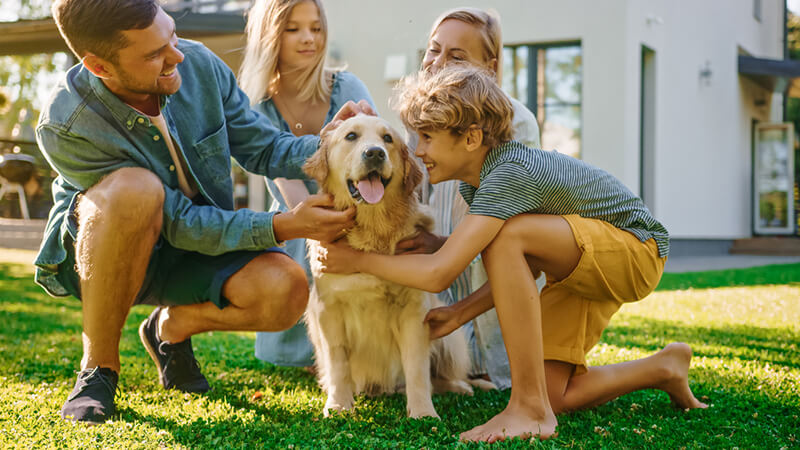
Gardens and pets, both wonderful on their own, tend to make for a nightmarish combination.


Though gardens can be stimulating places for pets, they can also contain various hazards such as toxic plants, harmful chemicals, and sharp or heavy objects. Our furry friends can cause havoc too, digging up plants or using spots in your yard as their new and improved toilet. This doesn’t always have to be the case, there are several things you can do to ensure a harmonious environment where your garden and your pet can coexist peacefully.
Gardening with pets in mind (commonly referred to as dog-scaping or cat-scaping) is the practice of identifying and eliminating problems and potentially hazardous elements, coming up with creative solutions and alternatives that respect the most common animal behaviors, and guarantee your pet’s safety. Petscaping practices include gardening with non-toxic plants, creating dedicated areas for your pet to lounge and have fun, and most importantly keeping your green space secure.
It's important to note upfront that every outdoor renovation that caters to the needs of specific pets is going to be unique. For instance, a cat won’t need a spot dedicated to digging, and a dog won’t need a hiding spot; their needs and behaviors are fundamentally different. With this in mind, we’ve included a guide with both cat-scaping and dog-scaping essentials that will help you create the perfect space to give your pet a better life!
Pet-friendly landscaping practices guarantee you will protect your pet from potential danger and your garden from expected damage. Schedule your professional design consultation today! Our team of design professionals will assist you throughout your entire makeover process, ensuring the best results for you and your faithful pets.
How to create a safe and welcoming space for your pet
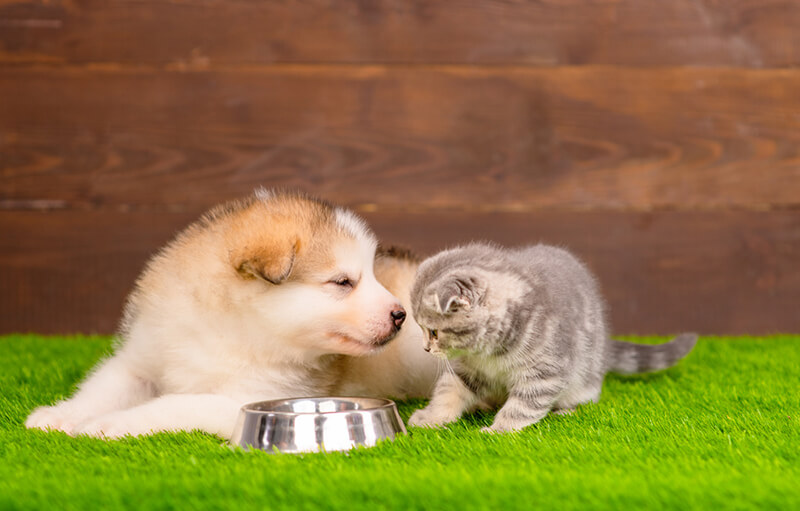
Cats and dogs can be significantly destructive to gardens and flower beds due to digging habits, and their urine can also cause severe lawn damage; this is less common with cats because they tend to prefer to pee in the dirt to cover it up. More energetic dogs can cause damage to younger or more delicate plants by digging them up or running over them.
To these common issues, we suggest the following solutions:
- Cover the soil with rough mulch such as landscape rocks or pine straw to prevent your pet from digging. Avoid using cocoa bean mulch, it is toxic for both cats and dogs and can be dangerous to include, they could nibble on it and you wouldn’t know until too late.
- Plant large perennials and robust plants such as nepeta, astilbe, and hardy geranium (not to be confused with Pelargonium species, which share the common name geranium, but can be toxic to dogs). These plants can withstand your pet’s attempts at digging them up and the impact of their paws running over them.
- You can plant cat repellent plants on a border around the areas of your garden you’d like to keep them away from. Rosemary and curry plants tend to repel cats due to their strong scent but aren’t toxic.
- To prevent lawn damage from pet urine (you can easily identify this issue by looking for brown spots in your yard), you can set up an outdoor litter box if your kitty is the culprit, or you can also go for the more universal solution of replacing your lawn with hardy grass alternatives that are less likely to die as a result of urine and digging.
The best hardy grass types that are safe for dogs and cats are:
- Tall fescue
- Kentucky bluegrass
- Perennial ryegrass
- Bermudagrass
- Zoysiagrass
Toxic and non-toxic elements
Some dogs and cats will chew on anything, which is why once you start making plans for your new garden, you must keep these two toxic and non-toxic plant lists handy, so you can make sure you’ll pick the best (and safest) options!
- American Society for the Prevention of Cruelty of Animals’ Toxic and Non-Toxic Plants List
- Veterinarians.org Indoor and Outdoor Safe Plants List
Many of the most common plants are not safe for cats and dogs, some can be toxic to them when ingested, and could cause seizures, tremors, or worse effects. Keep these two certified lists handy throughout your renovation process to ensure that any plants you grow in your new outdoor space are safe and non-toxic to your beloved pets!
Toxic chemicals and allergic reactions
Unfortunately, hazardous elements don’t end at common indoor and outdoor plants. Many substances that are regularly used in gardens and outdoor spaces can be toxic, and even lethal for pets. Pet Poison Helpline and ASPCA have detailed lists of toxic substances for pets and provide phone support for owners:
- Pet Poison Helpline, 855-764-7661, https://www.petpoisonhelpline.com/poisons
- ASPCA Animal Poison Control Center, 888-426-4435, https://www.aspca.org/pet-care/animal-poison-control/poisonous-household-products
If you think your pet has been exposed to a toxic substance, contact your veterinarian as soon as possible, even if your pet is not showing any noticeable symptoms (as these could take some time to start showing).
Symptoms may include vomiting, skin irritations, seizures, and diarrhea among others, depending on the substance and the amount your pet’s been exposed to.
Your pet could also have allergies or sensitivities to certain plants or substances, even if they’re not considered generally toxic. Redness in your pet’s coat, skin, and ears can be a telltale sign that they’re experiencing sensitivity or allergies. Check with your vet if you notice anything out of the ordinary.
Gardening with Cats in Mind
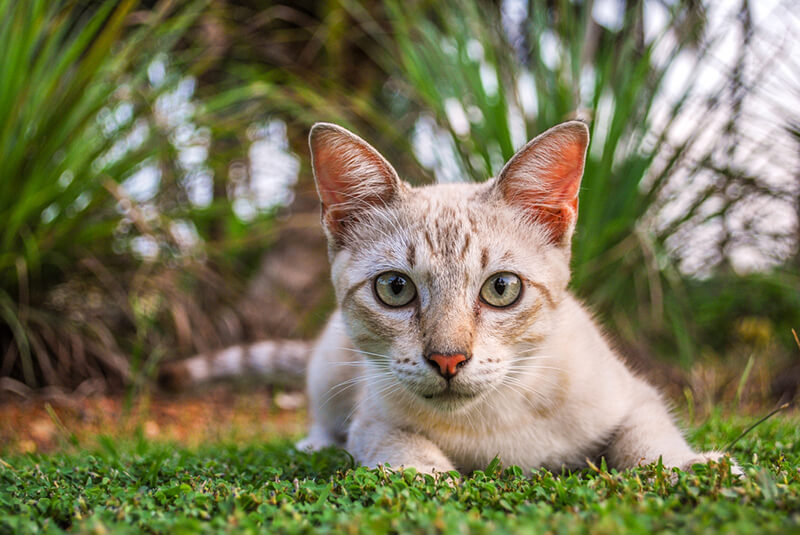
Due to their natural curiosity, cats have an inherent need for exploration, they love to hide, climb, and pounce. Reserving an area in your garden just for them is sure to keep them happy and entertained.
That being said, it’s dangerous to allow your cat to roam free and unsupervised through an open outdoor area. Kitties are known for their devil-may-care attitude, and if they think they have a chance to escape, they probably will (or at least they will try). In attempting to run away, they could get hurt, and if they successfully escape, they could get lost, hurt in a fight, get exposed to viral diseases, stolen, or injured in traffic. With this in mind, if you’re considering cat-scaping, you must be willing to plan for a safe, enclosed garden where they can lounge, play, and stay fit!
Your cats should feel like they have their own territory within your yard. You can easily achieve this by creating designated outdoor play areas, including mounds of dirt, mulch, or sand, climbing structures, and scratching posts to keep them comfortable, happy, and occupied. With a combination of these elements, you’ll make sure they won’t entertain themselves by digging up your flowers, and that they won’t use other precious areas of your garden to go potty. Mulched pathways will be softer on their paws, providing a safe landing for them. To pique their interest and add to the fun, you can include toys attached to strings or tied to branches.
How to make sure the area is secure
Keeping an escape artist cat safe outdoors is possible with the right strategy.
Cat fencing allows felines to enjoy any space safely! The number of specialized fencing manufacturers is steadily increasing as cat-scaping grows in popularity. Since cats can jump and climb rather high, a cat-proof fence made of sturdy material such as metal, panels of chain-link or wire, or wood is installed to create a 45° inward angle at the top of a new or existing fence.
Kitties can easily fit through small crevices, so for guaranteed safety, you should make sure there are no gaps larger than a few inches under the fence (or anywhere in your yard), and it would be extra helpful to supervise them on their first days of going out to discourage any possible escape attempts. Due to their curious nature, they might try sticking their paws through any gaps they may find and you never know what dangers they could find on the other side. After their first few days or weeks of going out, they’ll get comfortable and used to this new environment, which will make an escape attempt much less likely to happen.
Depending on the final height of your fence, you might need to check permitting restrictions and requirements.
If specialized fencing doesn’t sound ideal to you, another popular and practical alternative you could consider is crafting a custom outdoor cat house. They can be fun DIY projects for you and your family to get all hands on deck creating a safe space for your four-legged friend. It’s possible to build them around tree trunks, and this can be a fun spot for your cat to climb and nap.
Whether you go for specialized fencing or a DIY cat house, an enclosure should adapt to your home and garden’s aesthetics. If it sounds like too much to plan, ShrubHub can do it for you!
Enlist the help of our design professionals and we will match the enclosure design to your preferred style and turn it into something appealing to the eye, that will naturally blend in with the rest of your landscape.
Best plants for cats to include in your garden
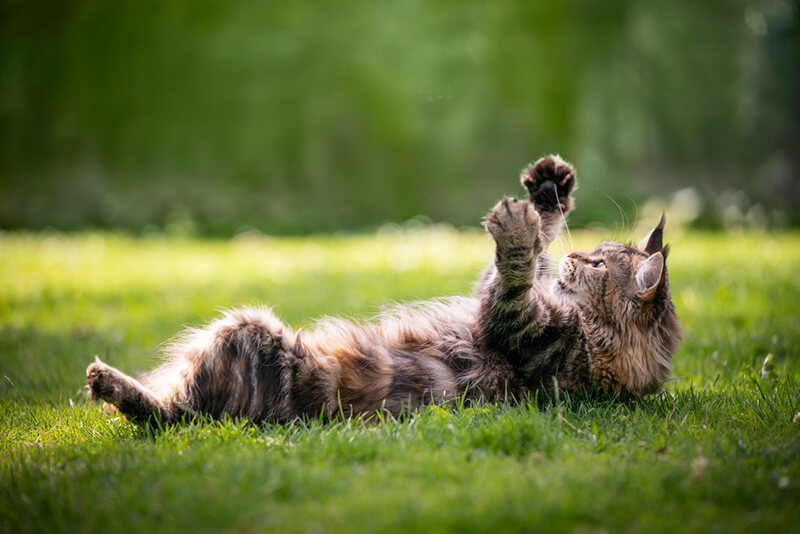
Although cats are carnivores, they love to nibble on plants from time to time, and they love some more than others.
For example, even if the reason why cats love catnip is yet to be discovered, kitties undeniably adore it. Consider it a must-have for your backyard. Pollinator-attracting plants, cat thyme, lavender, and valerian should go on your list as well.
Your cat will enjoy chasing the insects that pollinator-attracting plants will bring to your yard, and some of the plants themselves will add nutrients to your cat’s diet; you can grow them in the ground or in a container. Adding lemongrass or cat grass (which is a mixture of edible grasses such as oat, wheat, barley, and rye) is a bonus.
With these plants, you can create your cat’s own garden space, full of plants that are safe and fun for them to nibble on:
- Catnip
- Cat thyme
- Lavender
- Cat grass
- Lemongrass
- Valerian
Keep in mind that kitties can have too much of a good thing. Even if these plants are safe for cats, if they ingest them in massive amounts it will probably result in upset stomachs, vomiting, or diarrhea. Overeating on plants might be a sign of nutrient deficiency, make sure to consult with your vet if you catch your cat gorging on plants rather than occasionally nibbling on them.
Make sure to keep the aforementioned harmful plants lists handy to avoid including any plants that will be dangerous for your cat, such as lilies, azaleas, and daffodils among others.
Water fountains
Generally, cats don’t drink enough water, which can lead to health issues such as kidney or bladder problems in old age. Even though they don’t like getting wet, they’re more likely to drink running water due to their natural instincts. They are prone to thinking standing water might be full of bacteria (and they’re not entirely wrong).
Providing a source of running water can encourage your cat to drink more, so a fountain with a built-in filter can be a great option for clean and bacteria-free water. You can opt for one that doesn’t include a filter, but it will demand a high-maintenance cleaning routine that can get tiring in the long run.
Hiding spots
As all cat lovers know, felines love warm (and generally dark) enclosed spaces where they curl up and hide from the world. Providing them with safe hiding places is a must, and can serve as a source of shade for hot summer days. Shrubs are a great addition to any garden, and when it comes to cat-scaping, they are considered some of the best hiding spots. For pops of color and added cover in winter, you can add evergreen varieties planted close together to help create fun hiding spaces!
Cat-scaping practices are more simple than you may have originally thought. Outdoor cat houses can be a cute addition to your garden to serve as play and lounging areas for your furry friends, and they can be an exciting DIY project you and your family can craft with rather inexpensive materials. All your kitties need is plenty of insulation to keep them warm and cozy, plants for them to nibble on, places to climb, and hiding spots for their time of rest and relaxation.
Gardening Tips with Dogs in Mind
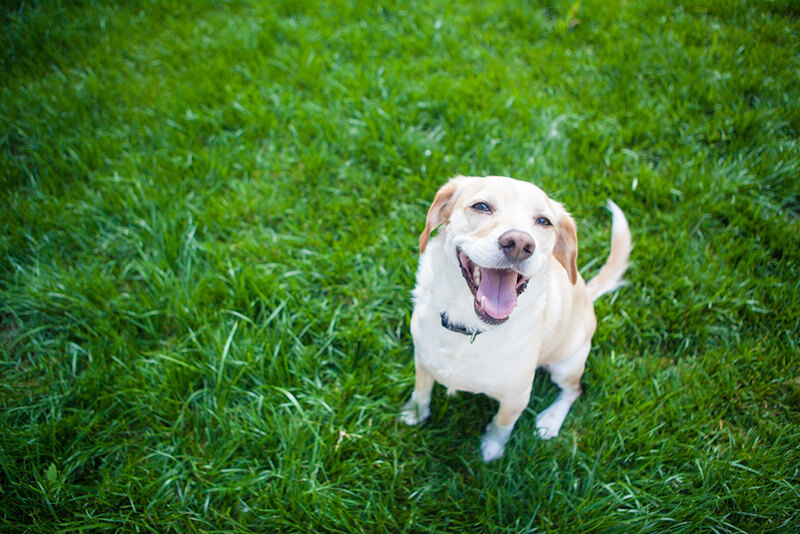
A lot can be done to a garden to make it a wonderful, stimulating place for your dogs. But just as we explained about cats and outdoor dangers, dogs are not immune to hazards such as potentially toxic plants and harmful chemicals. They can also be a little destructive, urinating on your favorite flowers or digging on your freshly mowed lawn. What can you do to ensure harmony between your dog and your landscape?
First and foremost, observe your dog’s habits and patterns. Dogs will look for cool places to relax on hot summer days, so you should prioritize creating easy-access shaded areas for your dog to chill out in hot weather. Additionally, some dogs tend to have their own patterns to enthusiastically run around specific perimeters and investigate every time they hear a noise outside, even more so if your garden is fenced. You know your puppy has no ill intentions towards your yard, but this generally results in precious, tender plants being (accidentally) crushed.
We recommend clearing out a small area or path along a frequented fence line, incorporating mulch to provide a mud-free surface and a sturdy hedge made of evergreen plants. Some safe options to consider include silverberry, juniper, crimson bottlebrush, southern wax myrtle, sweet osmanthus, and Camellia japonica.
How to make your garden stimulating and safe
Younger dogs love to play around and have some fun jumping, running, swimming, and climbing; they love playgrounds as much as children do. The amount of online DIY tutorials for dog playgrounds is endless, and you can build one yourself in your backyard to give your pup the perfect space to exercise and play, improving their overall health and fitness, while spending time with them and (if you’re willing to give it a shot) simultaneously training them as well.
If a dog playground is a little too much for you, creating designated play areas, clearly defined paths for them to run around, and incorporating different textures with plants and grasses should be enough to keep your dog stimulated and happy. Plants such as salix and ornamental grasses can be very stimulating for their paws!
Digging is a natural dog behavior, and stopping them from digging could upset them. Create designated digging arrears for them, and pay attention to your dog’s digging habits, as they can dig under fences and end up escaping. Make sure your fence’s borders are secure at the base, and regularly check for potential damage that could result in holes!
These are some of the best plants to ensure your garden is safe and alluring for your furry friend:
- Rosemary
- Lavender
- Calendula
- Sunflower
- Cornflower
- Sage
Avoid planting daffodil bulbs, yew, wisteria, foxgloves, and hydrangea as they are toxic for dogs and could be fatal when ingested. Don’t forget to check out ASPCA’s website and Veterinarians.org for full lists of harmful plants.
Protect Your Edibles
Rule number one when keeping your pup near your edible garden is to install a fence around it to keep your dog out.
Even if you are only planting pet-friendly edibles, you don’t want them overeating and running the risk of them ingesting certain parts of your plants that should never be eaten. You should also make sure your fertilizer is dog-friendly: always check the ingredients are non-toxic! The same applies to mulch, consider consulting with your veterinarian about any specific mulch or fertilizer you’d like to use before incorporating them into your gardening routine.
If lack of space doesn’t allow for a fenced, edible garden, you can opt for hanging planters or containers and place them away from your dog’s reach. Less durable plants, herbs, and veggies should be planted higher up in pots and containers to make for more interesting pops of color, preferably on decks and patios, or other heavily transited areas of the garden.
Get Outdoors Together
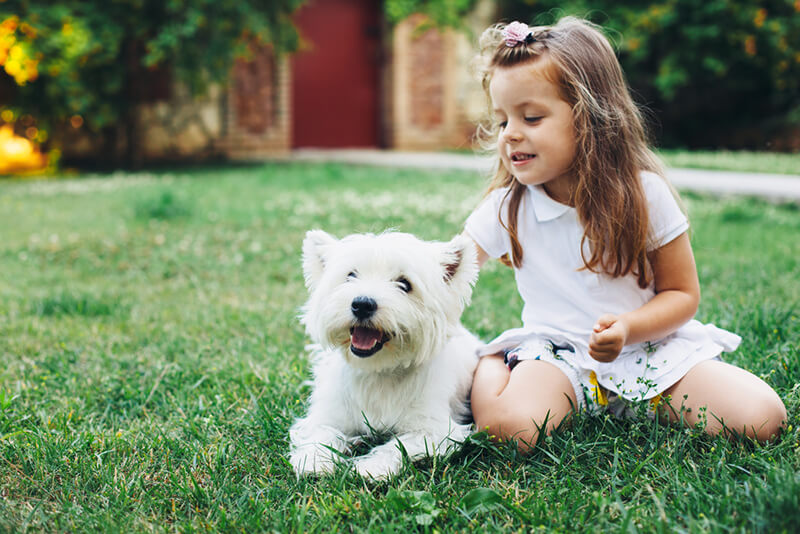
Transforming your green space into a safe, stimulating environment full of risk-free plants and entertaining play areas is only a few clicks away.
Our entire yard design package is done online, which means you can start your renovation from the comfort of your own home! With the guidance of an experienced Project Manager, we will bring your dream yards to life, and thanks to our very latest 3D technology, you’ll know exactly how everything will look from an eye-level perspective as if you were walking through your yard.
Gardens are lovely, relaxing areas for people, and they could be just as wonderful for your faithful pets!
Design Your Animal Safe Yard Today!


